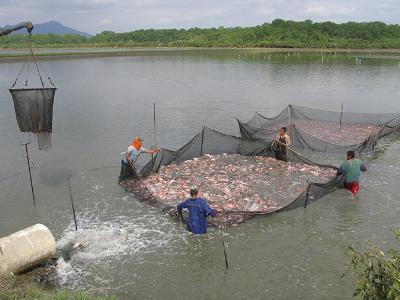Addressing safety in Latin America’s tilapia supply chain
Successful farmers adopt conservative practices to avoid losses caused by biosecurity problems. With worldwide, increasingly strict export standards for seafood
 Dietary organic acids used as growth promoters, anti-microbials
Dietary organic acids used as growth promoters, anti-microbials The intensification of tilapia culture systems has led to this hardy fish being susceptible to various bacterial diseases causing economic losses to tilapia far
 Shift in farmed fish feed may impact nutritional benefits
Shift in farmed fish feed may impact nutritional benefits The aquaculture industry is increasing its use of plant-based ingredients in its feed and moving away from traditional feed made from fish
 Increased density improves grouper feeding response, growth
Increased density improves grouper feeding response, growth Provided that optimum water quality parameters are maintained, white grouper can be a suitable candidate for intensive farming systems.
 Biomass density affects bass production
Biomass density affects bass production In RAS, feed conversion, growth rates not impacted. Biomass density affects bass production. Arkansas is the leading producer of food-size
 Virulent Aeromonas hydrophila in channel catfish
Virulent Aeromonas hydrophila in channel catfish New waterborne challenge model will facilitate urgently needed studies. Virulent Aeromonas hydrophila in channel catfish
 In Canada, salmon farmers building social license with First Nations
In Canada, salmon farmers building social license with First Nations Companies like Grieg and Marine Harvest are finding harmony with several native communities.
 F3 blows past funding goals as fishmeal alternatives proliferate
F3 blows past funding goals as fishmeal alternatives proliferate Seventeen companies vying for contest’s still-growing cash prize. F3 blows past funding goals as fishmeal alternatives proliferate
 Fishmeal-free Atlantic salmon feed formulation shows promise
Fishmeal-free Atlantic salmon feed formulation shows promise Joint research between TCFFI, USDA and EWOS uses new diet for post-smolt to food-size fish. Fishmeal-free Atlantic salmon feed formulation shows promise
 Maximizing nutrition for adult marine fish
Maximizing nutrition for adult marine fish Digestible protein-digestible energy ratios key to optimizing feeding efficiency. Maximizing nutrition for adult marine fish
 Large-scale tilapia project driving aquaculture development in Ivory Coast
Large-scale tilapia project driving aquaculture development in Ivory Coast Has fish farming reached a turning point in sub-Saharan Africa? Large-scale tilapia project driving aquaculture development in Ivory Coast
 Pirarucu culture in the Brazilian Amazon
Pirarucu culture in the Brazilian Amazon Fledgling industry faces technological issues. The pirarucu or pacha (Arapaima gigas) is the largest freshwater fish reared in the Amazon.
 Soy-based feeds evaluated for production of Amazonian paiche
Soy-based feeds evaluated for production of Amazonian paiche Fast-growing species produced via aquaculture since 2009. Soy-based feeds evaluated for production of Amazonian paiche
 The importance of carotenoids in aquafeeds
The importance of carotenoids in aquafeeds The importance of carotenoids in aquafeeds. Powdered astaxanthin, a type of carotenoid. Pigments play prominent roles in finfish and shellfish nutrition
 Improving productivity, efficiency in Asian sea bass aquaculture
Improving productivity, efficiency in Asian sea bass aquaculture Study shows dietary additive potassium diformate improves growth and survival. Improving productivity, efficiency in Asian sea bass aquaculture
 Novel air-based system transfers large salmon during harvest
Novel air-based system transfers large salmon during harvest Pumps utilized by The Conservation Fund Freshwater Institute have minimal impacts on fish. In testing, sliding the fish by hand into the outlet channel
 Linking water treatment practices and fish welfare
Linking water treatment practices and fish welfare Products based on peracetic acid (PAA) have gained substantial attention during the last decade as a potential sanitizer to replace formaldehyde
 The importance of carotenoids in aquafeeds
The importance of carotenoids in aquafeeds Pigments play prominent roles in finfish and shellfish nutrition. The organic pigments known as carotenoids (also referred to as tetraterpenoids)
 Judicious use of phosphorous key to farmed fish health
Judicious use of phosphorous key to farmed fish health A new direction in our understanding of the cause of deformities. Dietary phosphorus is essential for growth and healthy skeletal development of farmed fish
 Gauging fatty acid composition in hybrid striped bass
Gauging fatty acid composition in hybrid striped bass Saturated and unsaturated fatty acids in aquafeeds have major influence on LC-PUFA content. The hybrid striped bass is an important aquaculture
